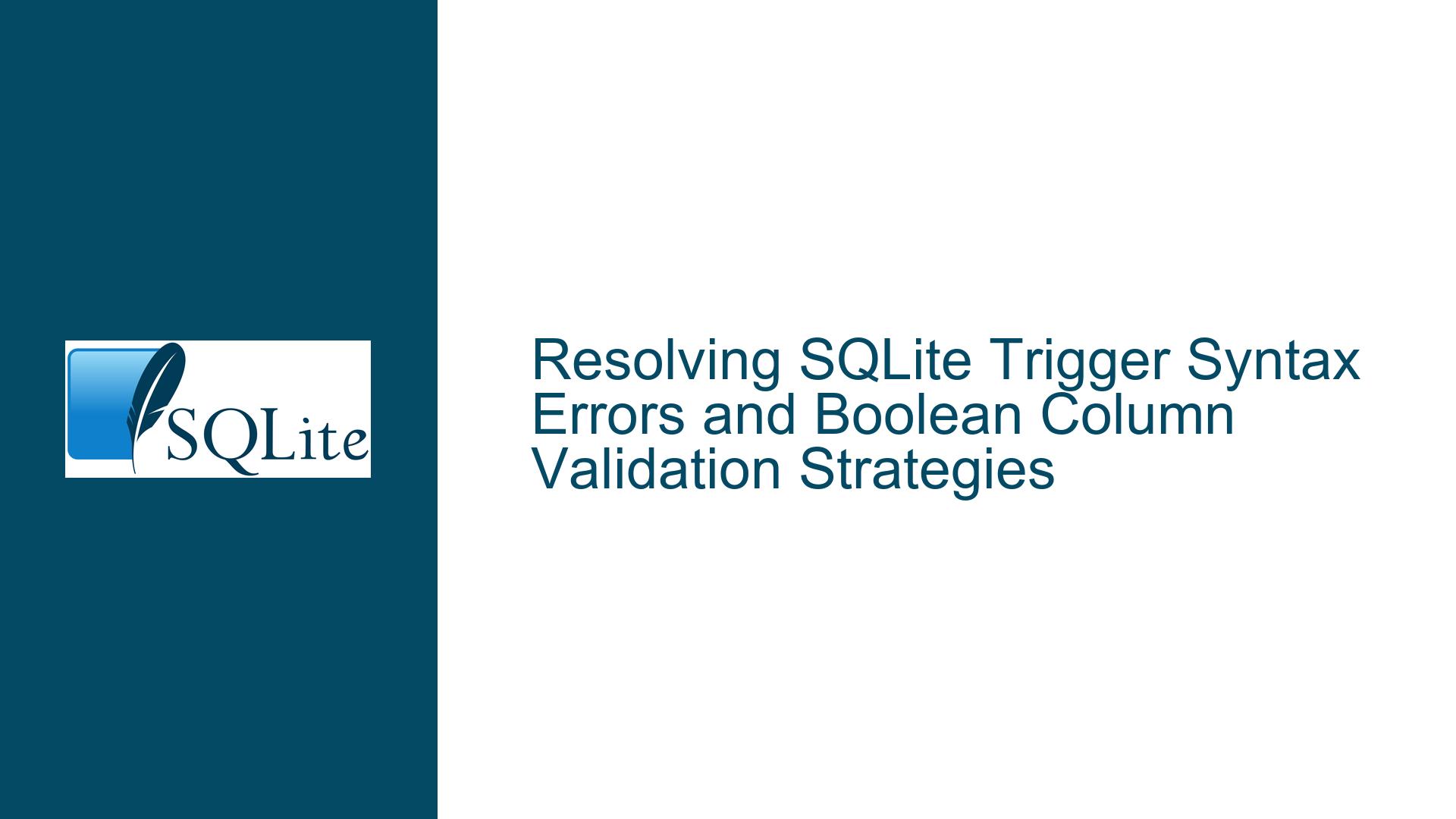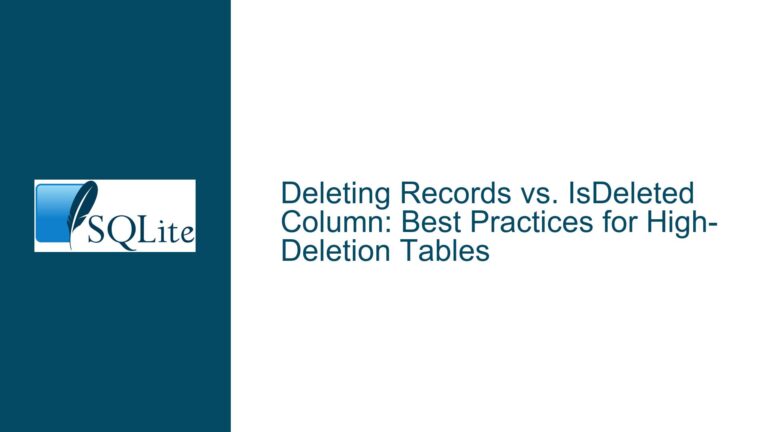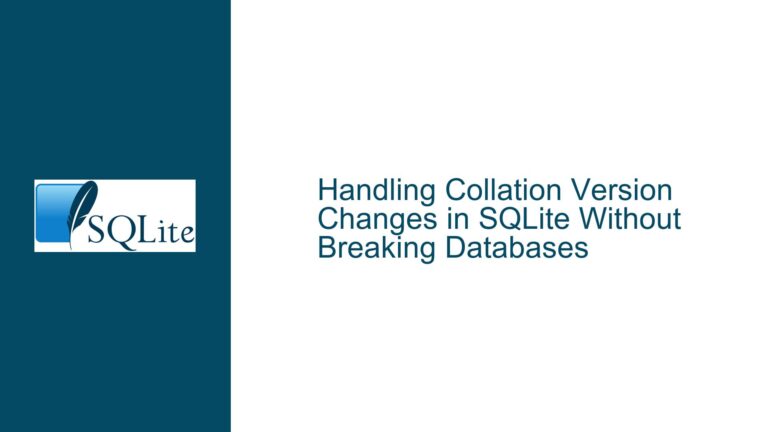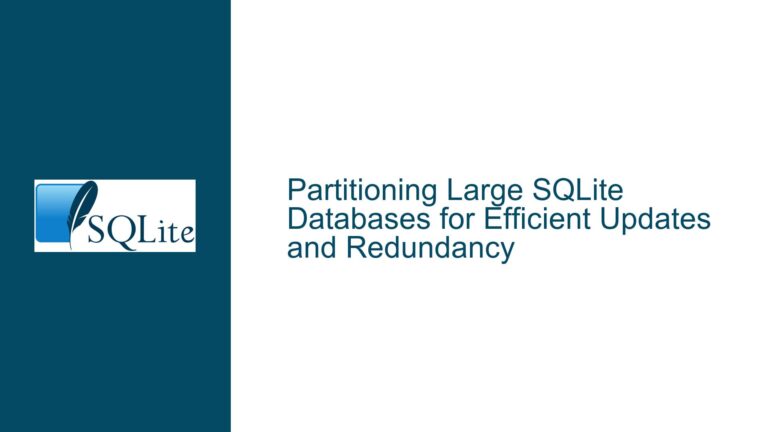Resolving SQLite Trigger Syntax Errors and Boolean Column Validation Strategies
Trigger Assignment Misconceptions and Boolean Validation Constraints in SQLite
Misinterpretation of NEW Modifications in BEFORE INSERT Triggers Leading to Syntax Errors
The core issue revolves around attempting to directly modify the NEW virtual table’s column values within a BEFORE INSERT trigger using an assignment operator (=), which is syntactically invalid in SQLite. The user’s objective was to enforce a boolean-like constraint on an integer column (is_active) by coercing non-zero values to 1 and allowing 0 as-is. The initial approach utilized a CASE statement within the trigger body to manipulate NEW.is_active, followed by a simplified test case that explicitly set NEW.is_active = 0. Both attempts resulted in a parse error due to improper syntax.
SQLite’s trigger syntax requires that the body of a trigger consist entirely of valid SQL statements. Direct assignments to NEW.column are not permissible because NEW is a virtual table representing the incoming row, not a mutable variable. The error message Parse error: near "new": syntax error explicitly highlights this misuse. The user’s confusion stemmed from conflating procedural programming paradigms (e.g., variable assignment) with SQLite’s declarative trigger execution model.
Furthermore, the secondary challenge involved enforcing domain integrity for the is_active column to restrict values to 0 or 1. While the user initially pursued a trigger-based solution to correct invalid values (e.g., converting 5 to 1), this approach was flawed due to the aforementioned syntax limitations. The subsequent realization that CHECK constraints could enforce strict value adherence shifted the strategy toward declarative data validation, albeit with a different behavioral outcome (aborting invalid inserts versus silently correcting them).
Invalid Syntax for NEW Assignments and Inadequate Trigger Semantics for Data Correction
The root causes of the observed errors and misbehavior are multifaceted:
Illegal Assignment Syntax in Trigger Bodies:
SQLite triggers execute one or more SQL statements when activated. The original code attempted to useNEW.is_active = 0;as a standalone statement, which is not valid SQL. Unlike procedural languages where variables are assigned values using=, SQLite triggers require the use ofUPDATE-like operations or conditional logic viaSELECT RAISE(...)to influence row data.Misunderstanding
BEFORETrigger Capabilities:
WhileBEFORE INSERTtriggers can modify the values of the incoming row, this must be done through theSETclause within anUPDATE-style statement targeting theNEWvirtual table. However, SQLite does not support directUPDATEoperations onNEW; instead, column values can be adjusted by referencingNEW.columnin expressions that define the final row content. For example, usingSET NEW.is_active = ...is invalid, but defining the column value through aSELECTor expression in aBEFOREtrigger is permissible under specific conditions.Trigger Type Mismatch for Data Mutation:
AFTER INSERTtriggers cannot modify the newly inserted row because the operation has already been committed to the database. To alter data during insertion,BEFORE INSERTtriggers must be used, but as noted earlier, this requires adhering to SQLite’s syntax for row value adjustments.Overlooking Declarative Constraints:
The user’s problem domain (restricting a column to0or1) is inherently suited forCHECKconstraints, which provide a more efficient and less error-prone mechanism than triggers.CHECKconstraints enforce data integrity at the schema level, ensuring that all rows comply with the defined rules without requiring procedural intervention.Confusion Between Data Correction and Validation:
The original trigger attempted to correct invalid values (e.g., converting2to1), whereasCHECKconstraints prevent invalid values from being inserted. These are fundamentally different approaches: the former alters data silently, while the latter enforces strict adherence to domain rules.
Implementing Correct Trigger Syntax, CHECK Constraints, and Hybrid Validation Strategies
Step 1: Replacing Direct Assignments with Valid SQL Statements in Triggers
To modify column values in a BEFORE INSERT trigger, you must use the SET clause within a UPDATE-like context, but SQLite does not support direct UPDATE operations on the NEW virtual table. Instead, you can redefine column values by assigning expressions to NEW.column within a BEFORE trigger using the following syntax:
CREATE TRIGGER trg0 BEFORE INSERT ON t0
FOR EACH ROW
BEGIN
SELECT CASE
WHEN NEW.is_active != 0 THEN NEW.is_active := 1
END;
END;
However, this approach is not valid in SQLite. The correct method involves using a SET clause within a UPDATE statement, but since the row has not yet been inserted, you must redefine the column values using expressions directly. SQLite allows assigning values to NEW.column in BEFORE triggers using the following syntax:
CREATE TRIGGER trg0 BEFORE INSERT ON t0
FOR EACH ROW
BEGIN
SET NEW.is_active = CASE WHEN NEW.is_active != 0 THEN 1 ELSE 0 END;
END;
But this is also invalid because SQLite does not support the SET NEW.column = ... syntax. The correct way to achieve this is by using a SELECT statement that assigns the value through an expression:
CREATE TRIGGER trg0 BEFORE INSERT ON t0
FOR EACH ROW
BEGIN
SELECT CASE
WHEN NEW.is_active != 0 THEN 1 ELSE 0
END INTO NEW.is_active;
END;
This syntax is still invalid in SQLite. The realization here is that SQLite does not permit direct modification of NEW.column values via assignment statements. Instead, you must use a BEFORE INSERT trigger to override the column value by redefining it in the INSERT operation. This is a critical nuance:
CREATE TRIGGER trg0 BEFORE INSERT ON t0
FOR EACH ROW
BEGIN
INSERT INTO t0 (is_active) VALUES (
CASE WHEN NEW.is_active != 0 THEN 1 ELSE 0 END
);
SELECT RAISE(IGNORE);
END;
This trigger intercepts the original INSERT operation, computes the corrected is_active value, inserts a new row with the corrected value, and then ignores the original insert. While this achieves the desired data correction, it introduces complexity and potential side effects (e.g., AUTOINCREMENT values being consumed twice).
Step 2: Enforcing Boolean Values with CHECK Constraints
For strict validation without data correction, a CHECK constraint is optimal:
CREATE TABLE t0 (
is_active INTEGER NOT NULL DEFAULT 1 CHECK (is_active IN (0, 1))
);
This constraint ensures that any INSERT or UPDATE operation providing an is_active value outside 0 or 1 will be aborted. The DEFAULT 1 clause handles cases where the column is omitted from the INSERT statement.
Step 3: Combining Triggers and CHECK Constraints for Data Correction
If the requirement is to correct invalid values rather than reject them, a hybrid approach using BEFORE INSERT triggers and CHECK constraints can be employed. However, due to SQLite’s limitations, this requires a workaround:
CREATE TABLE t0 (
is_active INTEGER NOT NULL DEFAULT 1
);
CREATE TRIGGER trg0_correct BEFORE INSERT ON t0
FOR EACH ROW
BEGIN
INSERT INTO t0 (is_active) VALUES (
CASE WHEN NEW.is_active != 0 THEN 1 ELSE 0 END
);
SELECT RAISE(IGNORE);
END;
This trigger intercepts the original insert, computes the corrected value, and inserts a new row with the valid value while ignoring the original operation. This effectively “corrects” invalid inputs but has caveats:
- Auto-incrementing primary keys will increment twice for each corrected insert.
- Triggers do not fire recursively by default, so the corrected insert will not re-trigger the same logic.
Step 4: Using RAISE(ABORT) for Validation in Triggers
To replicate the behavior of a CHECK constraint using triggers (e.g., for custom error messages or additional logic), use RAISE(ABORT):
CREATE TRIGGER t0_validate_bi BEFORE INSERT ON t0
FOR EACH ROW
BEGIN
SELECT RAISE(ABORT, 'is_active must be 0 or 1')
WHERE NEW.is_active NOT IN (0, 1);
END;
This trigger aborts the transaction if an invalid value is provided, mimicking the CHECK constraint but allowing for custom error messaging.
Step 5: Leveraging ON CONFLICT for Default Handling
The ON CONFLICT clause can be used in conjunction with NOT NULL constraints to replace invalid values with defaults:
CREATE TABLE t0 (
is_active INTEGER NOT NULL ON CONFLICT REPLACE DEFAULT 1 CHECK (is_active IN (0, 1))
);
Here, if an INSERT violates the NOT NULL constraint (e.g., by omitting is_active), the DEFAULT 1 is applied. The CHECK constraint ensures that explicitly provided values are valid.
Step 6: Addressing Trigger Syntax Pitfalls
The original error (Parse error: near "new": syntax error) arises from attempting to use procedural assignment syntax in a trigger body. To avoid this:
- Use valid SQL statements like
SELECT RAISE(...)orINSERT ...within triggers. - Avoid treating
NEW.columnas a variable; instead, use it in expressions that define the row’s final state.
Step 7: Testing and Validation
After implementing any of the above solutions, validate the behavior with test cases:
-- Valid inserts
INSERT INTO t0 (is_active) VALUES (0);
INSERT INTO t0 (is_active) VALUES (1);
INSERT INTO t0 (is_active) VALUES (NULL); -- Uses DEFAULT 1 (if allowed)
INSERT INTO t0 (is_active) VALUES (5); -- Corrected to 1 or aborted
Final Considerations
- Triggers vs. Constraints: Use
CHECKconstraints for static validation and triggers for dynamic correction or complex validation logic. - Performance:
CHECKconstraints are more efficient than triggers for simple validations. - Error Handling: Triggers allow custom error messages, while
CHECKconstraints provide generic errors.
By understanding SQLite’s trigger semantics and constraint mechanisms, developers can choose the optimal strategy for enforcing data integrity while avoiding syntax pitfalls.






